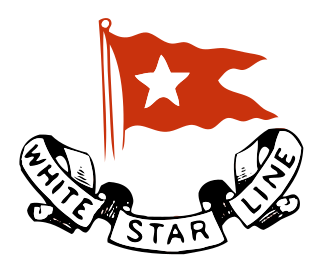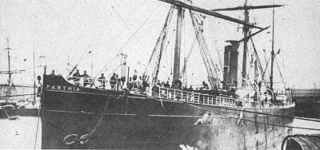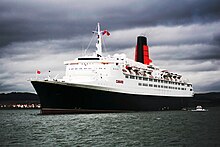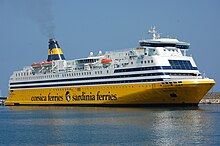
Queen Elizabeth 2 (QE2) is a retired British passenger ship converted into a floating hotel. Originally built for the Cunard Line, the ship was operated by Cunard as both a transatlantic liner and a cruise ship from 1969 to 2008. She was then laid up until converted and since 18 April 2018 has been operating as a floating hotel in Dubai.

Cunard Line is a British shipping and cruise line based at Carnival House at Southampton, England, operated by Carnival UK and owned by Carnival Corporation & plc. Since 2011, Cunard and its three ships have been registered in Hamilton, Bermuda.

RMS Queen Elizabeth was an ocean liner operated by Cunard Line. In tandem with Queen Mary both ships provided a weekly luxury liner service between Southampton in the United Kingdom and New York City in the United States, via Cherbourg in France.
Tonnage is a measure of the cargo-carrying capacity of a ship, and is commonly used to assess fees on commercial shipping. The term derives from the taxation paid on tuns or casks of wine. In modern maritime usage, "tonnage" specifically refers to a calculation of the volume or cargo volume of a ship. Although tonnage (volume) should not be confused with displacement, the long ton of 2,240 lb is derived from the fact that a "tun" of wine typically weighed that much.

An ocean liner is a type of passenger ship primarily used for transportation across seas or oceans. Ocean liners may also carry cargo or mail, and may sometimes be used for other purposes. Only one ocean liner remains in service today.

The White Star Line was a British shipping line. Founded out of the remains of a defunct packet company, it gradually rose up to become one of the most prominent shipping companies in the world, providing passenger and cargo services between the British Empire and the United States. While many other shipping lines focused primarily on speed, White Star branded their services by focusing more on providing comfortable passages for both upper class travellers and immigrants.

Caronia was a 34,183 gross register tons (GRT) passenger ship of the Cunard Line. Launched on 30 October 1947, she served with Cunard until 1967. She was nicknamed the "Green Goddess" after her light green hull livery. She was one of the first "dual-purpose" ships, built both for 2-class transatlantic crossings and all 1st-class cruising. After leaving Cunard she was briefly Caribia in 1969, after which she was laid up in New York until 1974, when she was sold for scrap. While being towed to Taiwan for scrapping, she was caught in a storm on 12 August. After her tow lines were cut, she repeatedly crashed on the rocky breakwater outside Apra Harbor, Guam and broke into three sections.

A merchant ship, merchant vessel, trading vessel, or merchantman is a watercraft that transports cargo or carries passengers for hire. This is in contrast to pleasure craft, which are used for personal recreation, and naval ships, which are used for military purposes.
Gross register tonnage, or gross registered tonnage, is a ship's total internal volume expressed in "register tons", each of which is equal to 100 cubic feet (2.83 m3). Replaced by Gross Tonnage (GT), gross register tonnage uses the total permanently enclosed capacity of the vessel as its basis for volume. Typically this is used for dockage fees, canal transit fees, and similar purposes where it is appropriate to charge based on the size of the entire vessel. Internationally, GRT may be abbreviated as BRT for the German "Bruttoregistertonne".

Freedom of the Seas is a cruise ship operated by Royal Caribbean International. She is the namesake of Royal Caribbean's Freedom class, and can accommodate 3,634 passengers and 1,300 crew on fifteen passenger decks. The vessel also has 4 crew decks below the waterline. Freedom of the Seas was the largest passenger ship ever built from 2006 until construction of her sister ship, Liberty of the Seas in 2007.
Italian Line and from 1992 Italia Line, whose official name was Italia di Navigazione S.p.A., was a passenger shipping line that operated regular transatlantic services between Italy and the United States, and Italy and South America. During the late 1960s the company turned to running cruises, and from 1981 it became a global freight operator.

Queen Victoria (QV) is a Vista-class cruise ship operated by the Cunard Line and is named after the former British monarch Queen Victoria. The vessel is of the same basic design as other Vista-class cruise ships, including Queen Elizabeth. At 90,049 gross tonnage (GT) she is the smallest of Cunard's ships in operation. Her facilities include seven restaurants, thirteen bars, three swimming pools, a ballroom, and a theatre.

The Royal Viking Line was a luxury cruise line that operated from 1972 until 1998. The company was the brainchild of Warren Titus and had its headquarters at One Embarcadero Center in San Francisco.

Net tonnage is a dimensionless index calculated from the total moulded volume of the ship's cargo spaces by using a mathematical formula. Defined in The International Convention on Tonnage Measurement of Ships that was adopted by the International Maritime Organization in 1969, the net tonnage replaced the earlier net register tonnage (NRT) which denoted the volume of the ship's revenue-earning spaces in "register tons", units of volume equal to 100 cubic feet (2.83 m3). Net tonnage is used to calculate the port duties and should not be taken as less than 30 per cent of the ship's gross tonnage.
Ship measurements consist of a multitude of terms and definitions specifically related to ships and measuring or defining their characteristics.

Queen Mary 2 (QM2) is a British transatlantic ocean liner. She has served as the flagship of Cunard Line since succeeding Queen Elizabeth 2 in 2004. The ship was officially named Queen Mary 2 by Queen Elizabeth II in 2004 after the first RMS Queen Mary of 1936. With the retirement of Queen Elizabeth 2 in 2008, Queen Mary 2 is the only ocean liner in service in the world. It has a regular service between Southampton, England, and New York City, United States, and an annual world cruise.

This is a timeline of the world's largest passenger ships based upon internal volume, initially measured by gross register tonnage and later by gross tonnage. This timeline reflects the largest extant passenger ship in the world at any given time. If a given ship was superseded by another, scrapped, or lost at sea, it is then succeeded. Some records for tonnage outlived the ships that set them - notably the SS Great Eastern, and RMS Queen Elizabeth. The term "largest passenger ship" has evolved over time to also include ships by length as supertankers built by the 1970s were over 400 metres (1,300 ft) long. In the modern era the term has gradually fallen out of use in favor of "largest cruise ship" as the industry has shifted to cruising rather than transatlantic ocean travel.

SS Parthia (1870–1956) was an iron-hulled transatlantic ocean liner built for the Cunard Line by William Denny and Brothers in Dumbarton, Scotland. Her sister ships were the Abyssinia and Algeria. Unlike her two sisters, Parthia was smaller, built in a different shipyard and had a slightly different funnel arrangement. The Parthia was retired by Cunard in 1883 and sold to John Elder & Co., who subsequently transferred her to the Guion Line. After serving with the Guion Line and operating on trans-Pacific routes with the Canadian Pacific Railway Company, she was refitted and renamed Victoria.





















